Battle of Immae › Battle of Issus › Roman Shipbuilding & Navigation » Origins and History
Articles and Definitions › Contents
- Battle of Immae › Origins
- Battle of Issus › Origins
- Roman Shipbuilding & Navigation › Origins
Ancient civilizations › Historical places, and their characters
Battle of Immae › Origins
Definition and Origins
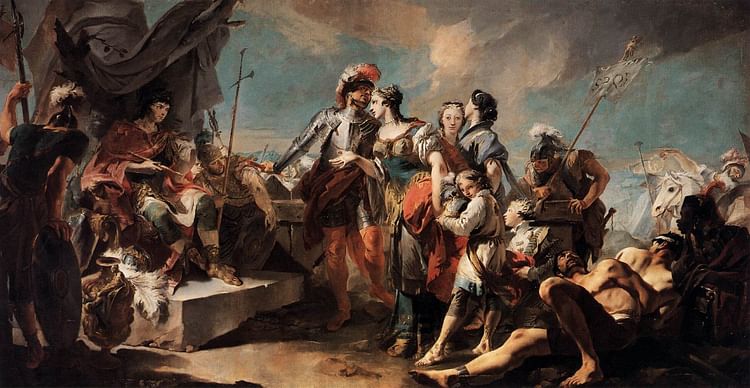
The Battle of Immae (272 CE) was fought between the forces of the Roman emperor Aurelian (270-275 CE) and those of the Palmyrene Empire of Zenobia (267-273 CE) resulting in a Roman victory and, ultimately, the capture of Zenobia and an end to her breakaway empire. Aurelian's use of strategy, turning the strength of Zenobia's forces to weaknesses, and his expert use of the element of surprise characterize the battle and led to his victory.
This engagement was not the decisive battle which toppled the Palmyrene Empire - that would come later at Emessa - but the Battle of Immae was almost a dress rehearsal for Emessa in that Aurelian would use the same tactics and Zenobia's forces would again be fooled by them and suffer another crushing - and final - defeat.
Zenobia had assumed rule of the eastern provinces of Rome after the death of her husband, Odaenthus, as regent for their son Vaballathus. She quickly took on the full responsibilities of leadership, however, without consulting Rome in any of her decisions. By 272 CE she had extended her territory from Syria and the Levant into Egypt and was in negotiations with the Persians when Aurelian defeated her forces and brought the Palmyrene Empire back under Roman control.
THE CRISIS OF THE THIRD CENTURY
The rise of the Palmyrene Empire was possible because of the period of instability and civil war in Rome known as the Crisis of the Third Century (also as the Imperial Crisis, 235-284 CE). The period began with the assassination of the sitting emperor Alexander Severus in 235 CE by his troops who objected to his decision to pay off the Germanic tribes for peace instead of engaging them in battle. Following Alexander ’s death, over 20 emperors would claim rule of the empire in the next 49 years.
CIVIL WARS, PLAGUE, WIDESPREAD INFLATION, & THREATS FROM BARBARIAN TRIBES ALL CONTRIBUTED TO THE INSTABILITY OF THE EMPIRE & ALLOWED FOR THE SO-CALLED "BREAKAWAY EMPIRES".
Civil wars, plague, a devaluation of the currency, widespread inflation, and threats from barbarian tribes at the borders all contributed to the instability of the empire at this time and allowed for the so-called "breakaway empires". In the west, the regional governor Postumus separated his territories from Rome as the Gallic Empire which included Germania, Gaul, Hispania, and Britannia, and in the east Zenobia quietly removed her lands from Roman control as well.
Although Zenobia's actions are often characterized as a rebellion, she was careful not to challenge Roman authority outright and, in fact, claimed to be acting in the interests of Rome. Postumus, after his initial strike against the emperor's heir and co-ruler, would claim the same: he was only doing what he thought best to defend the western territories against invasion during a time of crisis.
In spite of their protestations and official declarations, it is clear that both rulers had seized power of their respective regions and were acting autonomously without the consent or direction of the government of Rome. Even so, with so many threats – internal and external – to be dealt with, the emperors of Rome had little time or resources to bring either of these empires back under Roman rule. The emperor Gallienus (253-268 CE) attempted a campaign against Postumus but was driven back; no one, however, tried the same with Zenobia.
THE RISE OF PALMYRA
The Roman Emperor Valerian (253-260 CE) had made his son, Gallienus, co-emperor in 253 CE upon recognizing that the empire was too vast for one man to effectively govern. He placed Gallienus in charge of the west while he marched to secure the eastern regions against the Sassanid Persians. He was captured on campaign by the Persian king Shapur I (240-270 CE), and Gallienus, unable to come to his assistance, was left as the sole emperor.
Zenobia's husband, Odaenthus, was the Roman governor of Syria whose borders were among those Valerian had marched to protect from the Persians. When Valerian was captured, Odaenthus mobilized an army and attempted a rescue. Although he failed to free the emperor (who later died in captivity), he did manage to push the Persians back from Rome's eastern provinces; the very objective Valerian had mounted his campaign to achieve.

Roman Empire 271 CE
Odaenthus proved himself an able commander, and his loyalty and value to Rome were further proven when he put down a rebellion against Gallienus. In recognition of his efforts, Gallienus made Odaenthus governor of the eastern provinces below Syria, stretching down through the Levant. In 266/267 CE, however, Odaenthus was killed on a hunting trip and Zenobia took the reins of government as regent for their son Vaballathus and maintained her late husband's policies and cordial relationship with Rome.
In the chaos of succession which characterized the Crisis of the Third Century, Odaenthus may have thought that he could be chosen as the next emperor by proving himself of value to Gallienus and by amassing his own wealth to mount campaigns by plundering the cities of the Sassanid Persians. After his death, Zenobia may have considered that her son, or even she herself, could rule Rome and so continued her husband's reign as he had conducted it in her official interactions with the Roman government ; in her own region, however, she ruled as empress in everything but name. The historian Richard Stoneman writes:
During the five years after the death of Odaenthus in 267 CE, Zenobia had established herself in the minds of her people as mistress of the East. Housed in a palace that was just one of the many splendors of one of the most magnificent cities of the East, surrounded by a court of philosophers and writers, waited on by aged eunuchs, and clad in the finest silk brocades that Antioch or Damascus could supply, she inherited also both the reputation of Odaenthus' military successes and the reality of the highly effective Bedouin soldiers. With both might and influence on her side, she embarked on one of the most remarkable challenges to the sovereignty of Rome that had been seen even in that turbulent century. Rome, afflicted now by invasion from the barbarian north, had no strong man in the East to protect it...Syria was temporarily out of mind. (155)
Gallienus was assassinated in 268 CE and replaced by Claudius II who then died from fever and was succeeded by Quintillus in 270 CE. Throughout this time, Zenobia's policies steadily changed and, in 269 CE, seeing that Rome was too busy with its own problems to notice her, she sent her general Zabdas at the head of her army into Roman Egypt and claimed it as her own. Even this action could be justified as taken for the good of Rome since a rebel named Timagenes had instigated a revolt against the empire and Zenobia claimed she was only suppressing the rebellion. It is likely, however, that Timagenes was Zenobia's agent, sent to foment revolt to provide exactly the justification for invasion she needed.
The Palmyrene Empire now stretched from Syria down through Egypt, and Zenobia, without Rome's approval or consent, was in negotiations with the Persians and had at her command the Bedouin forces which could move swiftly and effectively over large areas and were well known as fierce fighters. While the Roman senate was floundering in their attempts to control events and emperors were either fighting off rival claimants or barbarian invasions, Zenobia was quietly building a sizeable and stable empire of her own. No emperor had the luxury to take notice or, if they did, to do anything about her until the cavalry commander Aurelian came to power.
THE BATTLE OF IMMAE
Aurelian had served with distinction under Gallienus as commander of the cavalry and then under his successor Claudius Gothicus (268-270 CE). He had a reputation as an effective leader who could see what needed to be done in any situation and acted swiftly to achieve results. In the period of the Crisis of the Third Century, these qualities in an emperor were highly prized, and Aurelian did not disappoint once he assumed leadership.
He secured the northern borders of the empire against an array of invading armies including the Jugunthi, Goths, Vandals, and Alammani, and later dealt severely with abuses concerning the official mint at Rome. He was able to control the chaos of the empire to the extent that regular practices of trade and commerce could be conducted as before. As soon as the most immediate threats were dealt with, he turned his attention east to Zenobia.
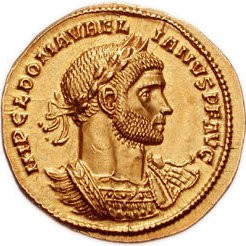
Coin Depicting Roman Emperor Aurelian
Unlike many of the other so-called " barracks emperors " of the period (those who came from the army), Aurelian was just as concerned for the well-being of the empire as he was for his own personal ambition and glory. He was not interested in entering into negotiations with Zenobia or sending messengers asking for explanations or justifications; as soon as he was reasonably ready to do so, he simply ordered his army about and marched on Palmyra.
Upon entering Asia Minor, he destroyed every city or village loyal to Zenobia and fought off various robber attacks while on the march, until he reached Tyana, home of the famous philosopher Apollonius of Tyana whom Aurelian admired. In a dream, Apollonius appeared to the emperor and counseled him to be merciful if he wished to obtain victory, and so Aurelian spared the city and marched on (another version of events claims Aurelian simply decided to be merciful without supernatural intervention).
Mercy proved to be very sound policy because the other cities recognized that they would do better to surrender to an emperor who showed compassion than incur his wrath by resisting. After Tyana, none of the cities opposed him and they sent word of their allegiance to the emperor before he ever reached their gates.
CITIES AFTER TYANA RECOGNIZED THAT THEY WOULD DO BETTER TO SURRENDER TO AN EMPEROR WHO SHOWED COMPASSION THAN INCUR HIS WRATH BY RESISTING.
Whether Zenobia tried to make contact with Aurelian before his arrival in Syria is not known. There are reports of letters between them before the battle but they are thought to be later inventions. The Historia Augusta, a famous 4th-century CE work whose reliability is frequently questioned, includes a section on Aurelian and details his attempts to resolve the conflict with Zenobia peacefully. This section, by Vopiscus, includes a letter he allegedly wrote to her at the start of his campaign demanding her surrender and also her arrogant response; both are thought to be fabrications created to highlight Aurelian's merciful and reasonable approach to the conflict as contrasted with Zenobia's haughty retort.
While Aurelian had been on the march, Zenobia's general Zabdas had rallied her troops near the city of Daphne, near Antioch (in modern-day Turkey ). Zabdas had complete confidence in his cataphracts (heavily armored cavalry) and the infantry who would support them. He arranged his army across the terrain to give his cavalry the greatest advantage in a charge. Aurelian, upon arriving, appeared to position his forces in a defensive response to Zabdas' formation.
Zabdas sent his cavalry against the Romans, forcing Aurelian to launch his own countercharge, and the two armies flew at each other. Just prior to engaging, however, the Romans wheeled their horses about, broke ranks, and retreated for their own lines. The Palmyrene cavalry followed quickly, and it would have seemed their victory was imminent, when the Romans turned back about and drove into them.
ZENOBIA'S DEFEAT
Aurelian had used Zabdas' great advantages of the terrain and his cataphracts against him: the ground which was so perfectly suited for a cavalry charge worked both ways and the pursuit of Aurelian's lightly armored cavalry by Zabdas' with their heavier armor tired the Palmyrenes significantly before they engaged in the battle. The element of surprise, of course, must also be considered a factor in Aurelian's victory.
The Roman infantry had by now engaged the enemy but there was no longer any real fight left in them; very few of the cavalry had returned alive to Zenobia's lines. She and Zabdas fled the field with what men they had and regrouped at Emessa. Here Aurelian defeated them a second time using exactly the same tactics he had at the Battle of Immae but adding infantry armed with heavy clubs. The Palmyrene forces were unable to defend against these weapons and most were slaughtered. Zabdas is presumed to have been killed in this engagement as he is not mentioned again in any of the records. Zenobia, however, escaped and fled to Palmyra. Aurelian, after looting the treasury at Emessa, followed her, but she slipped out of the city with her son and again eluded him.
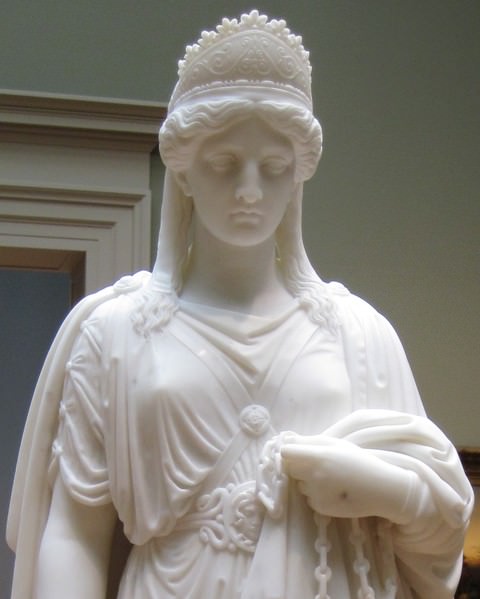
Zenobia in Chains
Precisely what happens next depends on which ancient source one reads, but in all of them, Zenobia is finally captured, brought before Aurelian, and taken back to Rome. The famous story of her being paraded through the streets in golden chains as part of Aurelian's triumph is almost certainly a later fabrication. Aurelian would have wanted to give the queen as little public attention as possible since it was already an embarrassment to him that he had needed to expend so much effort on subduing a woman. Whatever the details of her capture and transport to Rome, most sources agree that she married a wealthy Roman and lived out the rest of her days comfortably in a villa near the Tiber River.
CONCLUSION
The Palmyrene Empire was no more, and when Palmyra rose in revolt after their defeat, Aurelian returned and destroyed the city to make sure his position on rebellion was clear. He then marched to the other side of his empire and defeated Tetricus I of the Gallic Empire, slaughtering his army. Aurelian had restored the boundaries of the empire but would not live long enough to implement his policies regarding internal difficulties. He was assassinated by his commanders who mistakenly believed he was going to have them executed.
Had he lived, the Battle of Immae would have gone far in establishing Aurelian as a strong, decisive, but merciful emperor.When he first took Palmyra, he adhered to his policy of leniency and refused to have the members of Zenobia's court executed en masse; only select ringleaders were killed and those, it is thought, may have been implicated by Zenobia in order to save herself. It was only after the city rose a second time against him that he was forced to destroy them and their city.
The mercy he showed on his campaign through Asia Minor would, as noted, characterize his policies toward the leaders of the Gallic Empire. Immae - and later Emessa - were stunning victories for an emperor who, had he lived longer, would have probably been able to end the Imperial Crisis and save many lives. As it was, however, the crisis would continue another nine years until Diocletian (284-305 CE), developing many of Aurelian's policies, brought stability to the empire.
Battle of Issus › Origins
Definition and Origins
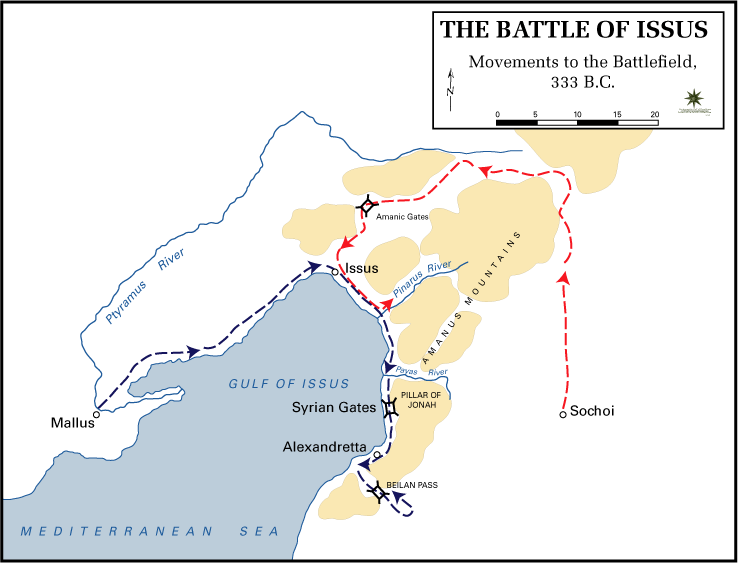
The Battle of Issus (5th November, 333 BCE) was Alexander the Great 's second battle against the Persian army and the first direct engagement with King Darius III, near the village of Issus in southern modern-day Turkey. It was a major victory for Alexander, defeating the Persian army and causing Darius III to flee the battlefield.
After the death of his father and his ascension to the Macedonian throne, Alexander's first order of business was to pursue his father's dream -- the conquest of the Persian Empire. Using the excuse that he was seeking revenge for the invasion of Greece by Darius I and Xerxes, Alexander crossed the Hellespont into Asia Minor. As he moved southward he defeated the Persian forces at Granicus and Halicarnassus. His next major confrontation would be at Issus in November 333 BCE. This battle would be the first of two meetings between Alexander the Great and King Darius of Persia -- both would end in a defeat of the Persian forces.
When Alexander learned of Darius's presence in the agricultural-rich land surrounding Issus, he quickly moved southward from Gordium through the Cilician Gates to the port town of Issus. Although the battle itself would be further south on a narrow plain between the Mediterranean Sea and the Amanus Mountains, the port served as a base camp for Alexander's forces. It was there that he left a number of wounded and sick to recover. Later, as Darius marched his troops to meet Alexander at the River Penarus, the Persian king stopped at the Greek base camp where he tortured and executed the recuperating Macedonian soldiers, cutting off the right hand of those who were allowed to live. This act would serve as a further incentive to Alexander's army to defeat the Persians.
THE TWO ARMIES MET AT THE RIVER PENARUS; THE WEATHER WAS RAINY AND COLD.
Focusing on his rendezvous with Alexander, Darius moved north from Babylon to an area east of the Issus River. Basing her estimates on ancient sources, historian Ruth Sheppard has Darius with an estimated army of between 300,000 and 600,000 as well as 30,000 Greek mercenaries while more modern numbers are from 25,000 to 100,000 with only 10,000 Greek mercenaries. Although he considered waiting there for Alexander, Darius changed his mind hoping to separate Alexander from his base at Issus and thereby isolating him. Alexander had marched south from Issus toward Syria, but after confirming the presence of Darius at Issus, he turned back to the north. Darius moved further south into the narrow strip of land west of the Amanus, thereby placing his forces at a disadvantage. The two armies met at the River Penarus; the weather was rainy and cold. The area did, however, provide a distinct advantage for Alexander because not only did it reduce Darius's mobility but he could also spread out his own troops.
Plutarch, in his The Life of Alexander the Great, spoke of this advantage and the victory it would soon bring when he said:
Fortune was not kinder to Alexander in the choice of ground, than he was careful to improve it to his advantage.For being much inferior in numbers, so far from allowing himself to be outflanked, he stretched his right wing much further out than the left wing of his enemies, and fighting there himself in the very foremost ranks, put the barbarians to flight.
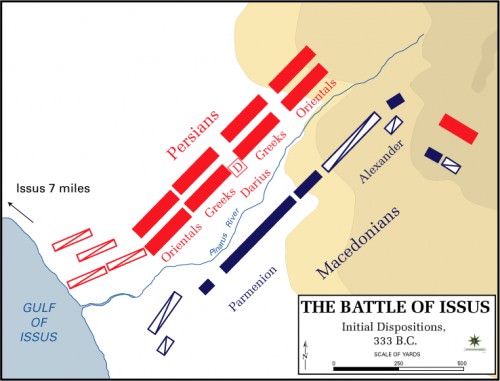
The Battle of Issus - Initial Dispositions
Unfortunately for Darius, he had ignored the advice of Charidamus, one of his trusted Greek generals, who had told Darius to divide his forces and allow him (Charidamus) to fight alone against Alexander. Darius ignored this suggestion for what some see as a matter of ego and prestige. He could not lose to this young Greek upstart. After being ignored, Charidamus made the mistake of a few ill-chosen comments about Persians. Darius, who spoke Greek and perfectly understood the comments, was offended and immediately had his general executed -- something many consider as unwise because Charidamus was viewed at one of Darius's most capable generals.
The entire battle did not go well for Darius. Despite the advantage of numbers, he and his men were soon on the defensive, unable to maneuver as they would have liked. Darius's left flank was hampered by the river valley, mountains on his left and the sea on his right.
Alexander, on the other hand, was able to use his trusted phalanx formation. His right flank extended to the mountains and his left to the sea. He had three battalions on the right and four to the left with heavy infantry in the middle. After viewing Alexander's formation, Darius moved his cavalry to attack Alexander's right with hopes of breaking through his right flank.Although hampered by the river bank and stockades erected by Darius, Alexander and his Companion cavalry moved quickly through the Darius's left flank. Attempts to drive Alexander back across the Pinarus failed. Historian Arrian in his The Campaigns of Alexander said:
Darius' Greeks fought to thrust the Macedonians back into the water and save the day for their left wing, in their turn, with Alexander's triumph plan before their eyes, were determined to equal his success and not forfeit the proud title of invincible, hitherto universally bestowed upon them.
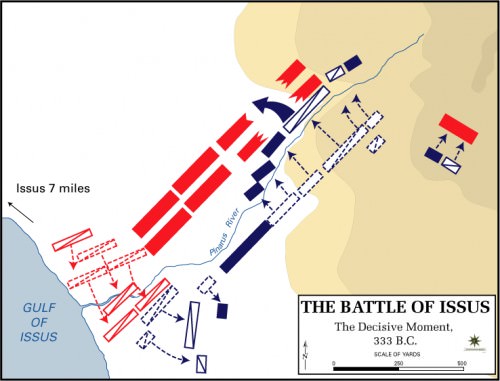
The Battle of Issus - The Decisive Moment
Alexander and his forces turned toward the Persian center where he spotted Darius. Although Darius's brother Oxathres attempted to block Alexander's charge, he failed. Darius fled the battle at first in his chariot and then on horseback. Despite a serious thigh wound, Alexander would pursue him until nightfall but returned empty-handed. Meanwhile, Alexander's left flank, under the leadership of Parmenion, was having problems with Darius's right. However, when the Persian forces saw their leader flee, they fled, too; many were trampled to death in the mass exit. In all the Persians lost 100,000 foot soldiers and 10,000 cavalry while Alexander only lost 1,200. These numbers are, as before, Greek estimates. Modern estimates are more reasonable having Darius lose around 20,000 and Alexander 7,000.The Persians left so hurriedly that there was much plunder awaiting Alexander and his men. Plutarch said:
…Darius's tent, which was full of splendid furniture and qualities of gold and silver, they (his soldiers) reserved for Alexander himself, who, after he had put off his arms, went to bathe himself saying, 'Let us now cleanse ourselves from the toils of war in the bath of Darius.
There was more than gold and silver, however, left behind -- Darius's mother, his wife, and two daughters were found in Darius's tent, but Alexander promised them that they would come to no harm. Plutarch wrote:
… (Alexander) let them know Darius was not dead, and that they need not fear any harm from Alexander, who made war upon him only for dominion; they should themselves be provided with everything they had been used to receive from Darius.
Although Darius sought the return of his family, promising Alexander half of his kingdom, Alexander refused. Instead, Alexander challenged him to stand and fight, and they would meet a second time at Gaugamela where Darius would again flee, but this time he would meet his death by one of his own -- Bessus.
Roman Shipbuilding & Navigation › Origins
Ancient Civilizations
Unlike today, where shipbuilding is based on science and where ships are built using computers and sophisticated tools, shipbuilding in ancient Rome was more of an art relying on rules of thumb, inherited techniques and personal experience rather than an engineering science. The Romans were not traditionally sailors but mostly land-based people who learned to build ships from the people that they conquered, namely the Carthaginians (and their Phoenician predecessors), the Greeks and the Egyptians.
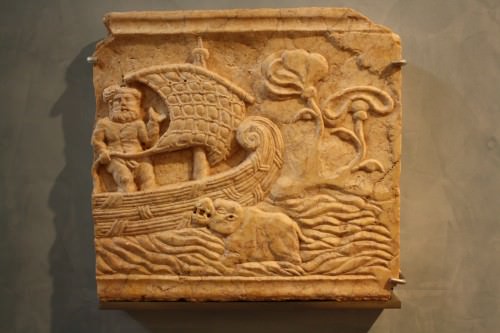
Ship Relief, Saguntum
There are a few surviving written documents that provide descriptions and representations of ancient Roman ships concerning the masts, sails and rigging. Excavated vessels also provide some clues on ancient shipbuilding techniques. What studies of these ancient documents and excavated vessels have taught us is that ancient Roman shipbuilders built the outer hull first, then proceeded with the frame and the rest of the ship. Planks used to build the outer hull were initially sewn together. Starting from the sixth century BCE, they were joined together using the locked mortise and tenon method. Then in the first centuries of the current era, Mediterranean shipbuilders shifted to another shipbuilding method, still in use today, which consisted of building the frame first and then proceeding with the hull and the other components of the ship. This method was more systematic and dramatically shortened ship construction times.
ROME'S NAVY BECAME THE LARGEST & MOST POWERFUL IN THE MEDITERRANEAN & THE ROMANS DOMINATED WHAT THEY CALLED MARE NOSTRUM ("OUR SEA").
WARSHIPS
Warships were built to be lightweight, fast and very manoeuvrable. They would not sink when damaged and often would lay crippled on the surface after a naval battle. They had to be able to sail near the coast, which is why they had no ballast and were built with a length to breadth ratio of the underwater hull of about 6:1 or 7:1. They had a ram often made of bronze which was used to pierce the hulls or break the oars of enemy ships. Warships used both wind and human power (oarsmen) and were therefore very fast.
Before the First Punic War which lasted 23 years (264–241 BCE), the Romans had very few warships. Actually, in 311 BCE, a committee was set up to plan for the development of the Roman navy. Back then, Rome only had 20 warships, all of them triremes, while Carthage, with the largest navy in the world, had hundreds of large quinqueremes. It is believed that the Romans copied a Carthaginian quinquereme which ran aground as it tried to block the passage of Roman ships on their way to Sicily. The Romans then managed to build 100 quinqueremes which were, however, heavier and far less manoeuvrable than their Carthaginian counterparts. Eventually, Rome's navy became the largest and most powerful in the Mediterranean and the Romans dominated what they called Mare Nostrum ("our sea").
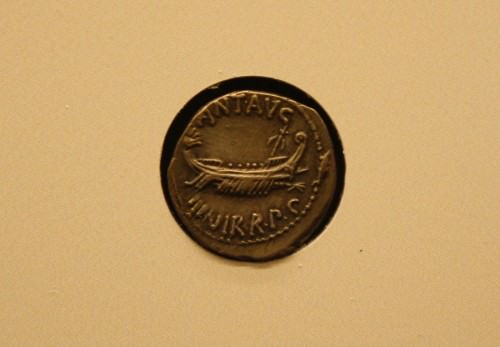
Praetorian Galley
The trireme was superseded by the larger quadriremes and quinqueremes. The quadrireme had four rows of oarsmen while the quinquereme had five. According to Polybius, the Roman quinquereme had a total of 300 rowers with 90 oars on each side. It was about 45 m long and 5 m wide and would displace around 100 tons. It was superior to the trireme, being faster and performing better in bad weather.
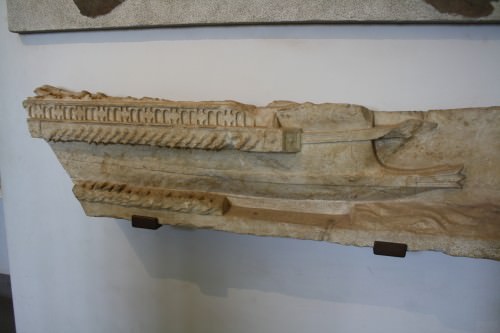
Roman Naval Vessel
MERCHANT SHIPS
Merchant ships were built to transport lots of cargo over long distances and at a reasonable cost, therefore speed and manoeuvrability were not a priority. They had a length to breadth ratio of the underwater hull of about 3:1, double planking and a ballast for added stability. Unlike warships, their V-shaped hull was deep underwater meaning that they could not sail too close to the coast. They usually had two huge side rudders (or steering oars) located off the stern and controlled by a small tiller bar connected to a system of cables. They had from one to three masts with large square sails and a small triangular sail called the supparum at the bow.
The Roman merchant ship's cargo capacity usually was between 100 to 150 tons (150 tons being the capacity of a ship carrying 3,000 amphorae ). The smallest ships had a capacity of 70 tons while the largest could have a capacity of 600 tons for a length of 150 feet (c. 46 m). Cargo included agricultural goods (eg grain from Egypt 's Nile valley, wine, oil, etc.), raw materials (iron bars, copper, lead ingots, marble, and granite) and other goods. Just like warships, merchant ships also used oarsmen. Following the collapse of the Roman Empire, no ships of the cargo-carrying capacity of Roman ships were built until the 16th century CE.

Roman Mosaic Showing the Transport of an Elephant
NAVIGATION IN ANCIENT ROME
Just like with shipbuilding, navigation in ancient Rome did not rely on sophisticated instruments such as compasses or GPS but on handed-on experience, local knowledge and observation of natural phenomena. In conditions of good visibility, seamen in the Mediterranean often had the mainland or islands in sight which greatly facilitated navigation. They sailed by noting their position relative to a succession of recognizable landmarks and used sailing directions. Written sailing directions ( periploi in Greek ) for coastal voyages were actually introduced in the 4th century BCE. They were initially written in Greek and they existed for trips in the Mediterranean. By 50 CE, there were written directions not only for the Mediterranean but also for routes from Atlantic Europe to the city of Massilia and for routes along the coast of north-west Africa, around the horn of Africa or past the Persian Gulf to India and beyond.
When weather conditions were not good or where land was no longer visible, Roman mariners estimated directions from the pole star or, with less accuracy, from the sun at noon. They also estimated directions relative to the wind and swell. A lot of the Romans' navigational skills were inherited from the Phoenicians. Pliny claimed that the Phoenicians were the first to apply astronomical learning gained from the Chaldeans to navigation at sea. For example, Phoenician seamen realized that the constellation Ursa Minor orbited the celestial North Pole in a tighter circle than did Ursa Major. As a result, they used Ursa Minor to give them a more precise direction of north.
When weather conditions were not good or where land was no longer visible, Roman mariners estimated directions from the pole star or, with less accuracy, from the sun at noon. They also estimated directions relative to the wind and swell. A lot of the Romans' navigational skills were inherited from the Phoenicians. Pliny claimed that the Phoenicians were the first to apply astronomical learning gained from the Chaldeans to navigation at sea. For example, Phoenician seamen realized that the constellation Ursa Minor orbited the celestial North Pole in a tighter circle than did Ursa Major. As a result, they used Ursa Minor to give them a more precise direction of north.
Both merchant ships and warships used wind (sails) and human power (rowers). Coordinating the hundreds of rowers was not an easy task and in order to solve this problem of rowers' coordination, a musical instrument, usually a wind instrument, would be played. Roman seamen also had to have a good understanding of natural phenomena, wind direction relative to the sail, and they had to know how to operate the sails in various weather conditions.

Roman Anchor Reconstruction
There were a large number of sailing routes with more or less regular schedules in the Mediterranean. Merchant ships would bring supplies from the provinces to the ports of the Italian peninsula. During the Empire, Rome was a huge city (for ancient standards) of about one million inhabitants. Goods from all over the world would come to the city through the port of Pozzuoli situated west of the bay of Naples and through the gigantic port of Ostia situated at the mouth of the Tiber River. For example, 1,200 large merchant vessels (of c. 350 tons) reached the port of Ostia every year or about five per navigable day. Large merchant ships would approach the destination port and be, just like today, intercepted by a number of towboats that would drag them to the quay.
The time of travel along the many sailing routes could vary widely. Ships would usually ply the waters of the Mediterranean at average speeds of 4 or 5 knots. The fastest trips would reach average speeds of 6 knots. A trip from Ostia to Alexandria in Egypt would take about 6 to 8 days depending on the winds. Travel from south to north or from east to west would usually take more time due to the unfavourable winds. It is worth noting that commercial navigation in the Mediterranean was suspended during the four winter months. This was called the Mare Clausum.
CONCLUSION
The ancient Romans built large merchant ships and warships whose size and technology were unequalled until the 16th century CE. Roman seamen navigated across the Mediterranean, Red Sea, and Indian Ocean and out into the Atlantic along the coasts of France, England and Africa. They had an advanced knowledge of navigation and navigated by the sighting of landmarks with the help of written sailing directions and by the observation of the position of celestial bodies, noting that navigational instruments such as the compass, albeit in use in China from the second century BCE, did not appear in Europe until the 14th century CE. During the Empire, there were a large number of busy shipping lanes in the Mediterranean or as the Romans called it Mare Nostrum bringing supplies from the far-away provinces to the ports of the Italian peninsula. Warships of the Roman navy, very fast and manoeuvrable, protected the shipping lanes from pirates. Overall, shipping in ancient Rome resembled shipping today with large vessels regularly crossing the seas and bringing supplies from the four corners of the Empire.
LICENSE
Article based on information obtained from these sources:with permission from the Website Ancient History Encyclopedia
Content is available under License Creative Commons: Attribution-NonCommercial-ShareAlike 3.0 Unported. CC-BY-NC-SA License